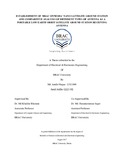| dc.contributor.advisor | Rhaman, Dr. Md Khalilur | |
| dc.contributor.advisor | Sagor, Dr. Md. Hasanuzzaman | |
| dc.contributor.author | Haque, Md. Arafat | |
| dc.contributor.author | Arifin, Jamil | |
| dc.date.accessioned | 2017-12-19T03:37:49Z | |
| dc.date.available | 2017-12-19T03:37:49Z | |
| dc.date.issued | 2017-08 | |
| dc.identifier.other | ID 12321008 | |
| dc.identifier.other | ID 12221102 | |
| dc.identifier.uri | http://hdl.handle.net/10361/8630 | |
| dc.description | This thesis report is submitted in partial fulfillment of the requirements for the degree of Bachelor of Science in Electrical and Electronic Engineering, 2017. | en_US |
| dc.description | Cataloged from PDF version of thesis. | |
| dc.description | Includes bibliographical references (page 70-71). | |
| dc.description.abstract | BRAC ONNESHA is the first Nano-Satellite of Bangladesh which opened path for students to start research in space engineering. BRAC Onnesha Ground station is the first Nano-Satellite Ground station of Bangladesh assembled and interfaced by BRAC University students. The BRAC ONNESHA Ground station setup has been studied in this Thesis. BRAC ONNESHA is a polar orbiting CubeSat. Polar orbiting satellite operations often require portability of ground station. Mostly the satellites in low earth orbit are Cube Satellites. Cube Satellites are small scale satellites whose electronics is consisted of extremely low power consuming components. For this reason the power of transmitting signal from Cube Satellites are very low powered making it very challenging for ground stations to receive the signals, especially in High Radio Frequency dense areas. As Satellites and their Ground Station is not cheap, for developing countries like Bangladesh it is quite difficult for researchers to avail a Portable Ground Station. It is very crucial for researchers to avail portability of satellite ground station as it is quite often required to receive signals from less Radio Frequency dense areas. For this purpose a low cost feasible ground station with a comparison of several antennas for VHF and UHF frequencies has been chosen to be analyzed in this report. The directional and omnidirectional antennas used for this portable ground station system can be easily constructed with raw materials available locally in Bangladesh. The system uses a KENWOOD Tri Band Handheld Radio as the system’s RF receiver and transmitter. | en_US |
| dc.description.statementofresponsibility | Md. Arafat Haque | |
| dc.description.statementofresponsibility | Jamil Arifin | |
| dc.format.extent | 75 pages | |
| dc.format.extent | 2017 | |
| dc.language.iso | en | en_US |
| dc.publisher | BRAC University | en_US |
| dc.rights | BRAC University thesis is protected by copyright. They may be viewed from this source for any purpose, but reproduction or distribution in any format is prohibited without written permission. | |
| dc.subject | BRAC Onnesha | en_US |
| dc.subject | Nano-satellite | en_US |
| dc.subject | Space engineering | en_US |
| dc.subject | Polar satellite | en_US |
| dc.subject | Cube Satellite | en_US |
| dc.subject | KENWOOD | en_US |
| dc.subject | BRAC University | en_US |
| dc.title | Eshtablishment of "BRAC Onnesha" nano sattelite ground station and comparative analysis of different types of antenna as a portable low earth orbit sattelite ground station receiving antenna | en_US |
| dc.type | Thesis | en_US |
| dc.contributor.department | Department of Electrical and Electronic Engineering, BRAC University | |
| dc.description.degree | B. Electrical and Electronic Engineering | |

